Welcome to a riveting exploration of the captivating history behind shipping containers – the unsung heroes that revolutionized international trade and globalization.
In today’s interconnected world, the ability to transport goods efficiently across vast distances is crucial for economic growth and cultural exchange.
This article will delve into the captivating story of how these seemingly humble steel boxes transformed logistics and supply chains, defining the very fabric of our modern global economy.
The roots of international trade can be traced back through the annals of human history, from the Silk Road of ancient times to the European Age of Discovery.
However, it wasn’t until the invention of the shipping container that the true power of globalization was unleashed.
These standardized, stackable boxes streamlined the movement of goods, drastically reducing shipping costs and enabling seamless intermodal transportation across diverse modes – from vessels to rail and road.
To fully appreciate the impact of shipping containers, a glimpse into the maritime history is essential. The shipping industry has played a vital role, facilitating exchange between continents and fostering economic booms.
From the grand seafaring vessels of early civilizations to the bustling ports of today, the ocean has served as the conduit for countless treasures, ideas, and cultures. The advent of shipping containers revolutionized this industry, forever changing the way goods were packed, loaded, and transported across the globe.
Whether you are a history enthusiast, a logistics aficionado, or simply curious about the origins of an essential element of our globalized society, this captivating journey through the history of shipping containers will shed light on their incredible significance.
Embark on this voyage with us and gain a deeper understanding of the unassuming heroes that quietly transport the lifeblood of world trade.
Table of Contents
Early Shipping Methods and Challenges

In the early days of shipping, before the introduction of shipping containers, transportation and cargo handling were significantly different. The process was more labor-intensive and time-consuming, leading to numerous challenges and limitations.
Pre-container Era Transportation and Cargo Handling
- Goods were transported using various methods such as barrels, crates, and sacks.
- These items were commonly loaded onto ships manually, requiring a large workforce and significant physical effort.
- Handling cargo without standardized dimensions posed difficulties in storage and transit.
Limitations and Inefficiencies in Traditional Shipping Methods
- Traditional shipping methods faced issues with stowage optimization and cargo security.
- Lack of standardized packaging made loading and unloading operations cumbersome and time-consuming.
- Goods were susceptible to damage, theft, and loss during transit due to inadequate protection and handling.
Impact of Globalization on Trade and Need for Improved Logistics
The rise of globalization and increased international trade led to a growing demand for enhanced logistics solutions. As trade routes expanded, it became clear that traditional shipping methods were becoming increasingly inefficient and costly.
- Businesses and countries needed a more streamlined and reliable way to transport goods over long distances.
- The need for standardized, secure, and efficient cargo handling became crucial to support the growth of global trade.
By recognizing the limitations of traditional shipping methods and understanding the challenges posed by globalization, the stage was set for the development of shipping containers and the revolution that would follow.
Malcolm McLean and the Birth of Containerization
In this section, we will explore the significant contributions made by Malcolm McLean to the shipping industry and how his innovative ideas ushered in a new era of containerization.
Overview of Malcolm McLean’s Contribution to the Shipping Industry
Malcolm McLean, a trucking company owner from North Carolina, played a crucial role in revolutionizing the transportation of goods across the world. In the 1950s, he identified the inefficiencies and challenges involved in shipping goods using traditional methods.
With a vision to streamline and simplify the process of transporting cargo, McLean developed the concept of containerization.
Introduction of Innovative Containerization and Standardization
McLean’s groundbreaking idea was to transport goods using standard-sized and stackable containers instead of individually loading and unloading cargo. By doing so, he aimed to improve efficiency, reduce costs, and enhance the security of goods during transit.
He introduced modified truck trailers, known as “intermodal shipping containers,” which helped facilitate seamless transfer of goods between different modes of transportation, such as trucks, ships, and trains.
How Standardized Shipping Containers Revolutionized Trade and Logistics
McLean’s standardized shipping containers brought about a paradigm shift in the shipping industry. By having a uniform size and shape, these containers enabled easy handling, stacking, and transportation of goods.
With containerization, the loading and unloading process became significantly faster and more efficient. Emphatically, it reduced the time spent in ports and allowed for quicker turnaround times, leading to increased productivity and cost savings.
The use of standardized containers also enhanced the safety and security of goods during transit. It minimized the risk of damage, theft, and loss, providing peace of mind to both shippers and recipients.
- Improved Efficiency: Loading and unloading time reduced by up to 90%.
- Reduced Costs: Lower labor, storage, and handling costs.
- Enhanced Security: Goods are better protected against theft and damage.
- Increased Productivity: Quicker turnaround times led to improved productivity.
Containerization revolutionized global trade and logistics, enabling businesses to transport goods more effectively and economically.
At any rate, it facilitated the growth of international trade by making it easier to ship goods across long distances, contributing to the globalization of economies.
The Evolution of Shipping Containers
Shipping containers have come a long way since their humble beginnings. Let’s explore how they have evolved over time, revolutionizing the transportation industry:
Exploration of the Various Types and Sizes of Shipping Containers
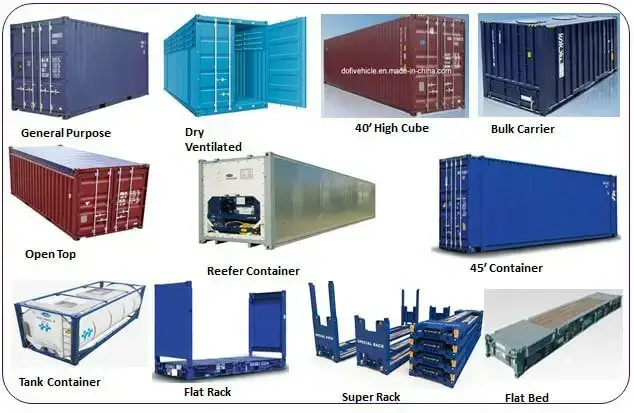
As the demand for more efficient shipping methods increased, so did the need for various types and sizes of containers. From standard dry containers to specialized refrigerated containers, the industry adapted to accommodate different cargo requirements.
Introduction of ISO Containers as an Industry Standard
In the 1950s, the International Organization for Standardization (ISO) introduced a standardized container size, known as the ISO container.
This standardization revolutionized containerization, making it easier to transport goods between different modes of transportation and ensuring compatibility among shipping companies worldwide.
How Shipping Containers Influenced the Design of Ships and Port Infrastructure
To begin with, the introduction of shipping containers had a profound impact on the design of ships and port infrastructure. To accommodate the increasing demand, ships were built with specialized cranes and gantry systems, enabling efficient loading and unloading of containers.
Port terminals were also redesigned with container yards and stacking systems, maximizing space and streamlining operations.
Shipping containers continue to influence the shipping industry in remarkable ways. In the next section, we will explore their role in intermodal transportation and multimodal systems.
Intermodal Transportation and Multimodal Systems
In the modern era of globalization, the demand for efficient transportation of goods across vast distances is higher than ever before.
Without a doubt, intermodal transportation and multimodal systems have revolutionized the way cargo is moved, making it faster, more reliable, and cost-effective.
Definition of intermodal transportation and its significance
Intermodal transportation refers to the movement of goods using multiple modes of transportation, such as trucks, trains, ships, and airplanes.
It involves the use of different types of containers that can be seamlessly transferred from one mode to another, without the need to unload and reload the cargo. This seamless transfer ensures that goods reach their destination faster and more efficiently.
The integration of different modes of transportation for efficient cargo movement
Intermodal transportation systems integrate various modes of transportation, such as road, rail, and sea, to create a cohesive and efficient network. Each mode of transportation is utilized for its specific strengths, optimizing the overall transportation process.
For example, trucks are used for short distance transportation, trains for longer distances, and ships for international shipping. By combining these modes, intermodal transportation systems provide a comprehensive solution for cargo movement.
How shipping containers facilitated the growth of multimodal transport systems
Shipping containers played a vital role in the development of multimodal transport systems. The standardization of container dimensions allowed for easy interchangeability between different modes of transportation.
Containers can be efficiently loaded onto trucks, trains, and ships, eliminating the need to handle individual pieces of cargo. This standardization not only reduced loading and unloading times but also enhanced cargo security and reduced the risk of damage during transit.
As a result, shipping containers facilitated the growth of multimodal transport systems by providing a seamless and adaptable solution for cargo movement.
| Image | Product Title | Features | Price |
|---|---|---|---|
 | Buy on Amazon | ||
 | Buy on Amazon | ||
 | Buy on Amazon |
What Is The Maximum Number of Containers That a Ship Can Carry?
The size of a ship and the number of containers it can carry depends on the type of vessel. A feeder’s vessel carries between 80 and 300 TEUs, while the main vessel carries between 400 and 1,200 TEUs. The largest container ships can carry up to 2,500 TEUs.
Read More on Why Container Shortage Compromise Global Logistics And Trade
Economic Impact and Cost Efficiency of Containerization
Containerization has had a profound economic impact on global trade, revolutionizing the way goods are transported across the world. Through detailed analysis, it becomes apparent that this innovative shipping method has brought numerous economic benefits.
Economic Benefits Brought by Containerization
Containerization has significantly contributed to cost savings, increased productivity, and economies of scale in the shipping industry. By standardizing the size and form of containers, the handling and transportation process became more efficient and streamlined.
- Cost Savings: Containerization has allowed for improved cost efficiencies due to reduced handling requirements. With faster loading and unloading times, containerization has minimized labor costs and expedited cargo delivery.
- Increased Productivity: With the introduction of containerization, the time spent at ports was greatly reduced. This led to increased vessel turnaround times and improved overall productivity in the logistics chain.
- Economies of Scale: The use of containers enabled the shipping industry to benefit from economies of scale. By transporting larger quantities of goods in a single container, shipping companies were able to achieve cost advantages and pass the savings on to their customers.
Examples of Containerization’s Economic Impact
Containerization has played a crucial role in lowering transportation costs and accelerating global trade. Here are some notable examples:
- Lowered Transportation Costs: Prior to containerization, cargo handling was a labor-intensive and time-consuming process. By standardizing container sizes and optimizing loading techniques, containerization significantly reduced cargo handling and transportation costs.
- Accelerated Global Trade: Containerization has facilitated the growth of global trade by making it faster, more reliable, and cost-effective. The ability to seamlessly transport goods between different modes of transportation, such as ships, trains, and trucks, has opened up new opportunities for international commerce.
- Integration of Supply Chains: Containerization has allowed for the integration of supply chains on a global scale. The ability to easily transfer goods between different modes of transportation has strengthened the connections between manufacturers, suppliers, and consumers in different parts of the world.
In conclusion, containerization has had a remarkable economic impact on the shipping industry. Its cost efficiency, increased productivity, and facilitation of global trade have transformed the way goods are transported, benefiting businesses and consumers alike.
Technological Advancements in Shipping Methods
Overview of the Evolution of Shipping Methods and Technologies
The history of shipping containers has seen significant technological advancements that have revolutionized the industry.
From the early days of traditional cargo handling to the modern era of digitalization, these advancements have vastly improved the efficiency and effectiveness of shipping methods.
In the early years, the process of loading and unloading cargo from ships was labor-intensive and time-consuming. Workers had to manually transport goods using rudimentary methods, resulting in slow and costly operations.
However, advancements in technology gradually introduced more efficient methods and tools for handling cargo.
Introduction of Specialized Container Handling Equipment
One major leap forward in shipping methods came with the introduction of specialized container handling equipment. Forklift trucks and gantry cranes were developed to handle containers, enabling faster and more precise loading and unloading of cargo.
These specialized machines revolutionized the shipping industry by significantly reducing the time required to transfer containers between ships and land.
As a result, the overall efficiency of cargo handling was greatly improved, leading to more streamlined operations and reduced costs.
Impact of Automation and Digitalization on Cargo Handling and Tracking
Automation and digitalization have played a crucial role in advancing the efficiency and effectiveness of shipping methods. The use of automated systems in cargo handling has replaced manual labor, resulting in faster and more accurate operations.
Furthermore, the introduction of digital technologies has revolutionized cargo tracking and monitoring. Advanced tracking systems allow for real-time visibility of containers, ensuring their security and enabling efficient logistics management.
With the implementation of automated and digital systems, the shipping industry has experienced significant improvements in efficiency, accuracy, and productivity.
These advancements have not only streamlined operations but have also enhanced customer satisfaction by providing better visibility and control over shipments.
Read More on An Exclusive Look At The Different Types Of Shipping Containers
Port Infrastructure and Operations
The development of ports to accommodate containerization has been crucial to the success and growth of the shipping container industry. Ports play a vital role in facilitating the movement of goods and connecting different regions through container shipping.
The infrastructure and operations at ports have evolved significantly to handle the demands of container shipping. Modern ports now feature specialized container terminals equipped with advanced equipment and technology to ensure efficient handling of containers.
Overview of Port Infrastructure
Port infrastructure is necessary to support the handling, storage, and movement of containers. This includes the construction and maintenance of berths, container yards, and storage facilities.
Container terminals within ports are designed with specific features like deepwater access, strong quay structures, and adequate crane capacity to handle the large vessels that transport containers.
These terminals also include spacious areas for stacking containers, with dedicated lanes for the movement of trucks and other vehicles.
Port Operations and Container Shipping
The operations at ports involve a series of coordinated activities to ensure the smooth transit of containers. This includes the arrival and departure of ships, the loading and unloading of containers, and the management of container storage and distribution.
Efficient port operations are crucial for container shipping to remain cost-effective and time-efficient. Ports invest in advanced technology and automation, such as automated stacking cranes and container tracking systems, to streamline the processes and minimize delays.
Contribution to the Success of Containerization
The efficiency of port operations directly impacts the success of containerization. Ports that are well-equipped and have streamlined processes can handle higher volumes of containers, reducing congestion and delays.
Efficient port operations also enhance supply chain reliability and flexibility. Containers can be quickly and accurately transferred between different modes of transportation, such as ships, trucks, and trains, allowing for smooth multimodal transportation.
In addition, efficient port operations contribute to the overall cost efficiency of containerization. With minimal delays and optimized processes, container shipping becomes a more economically viable option for businesses.
In conclusion, the development of port infrastructure and efficient port operations have played a pivotal role in the success and growth of containerization. As container shipping continues to expand, ports will continue to evolve and adapt to meet the ever-increasing demands of the industry.
Environmental Impact and Sustainability
As containerized shipping has become the backbone of global trade, it is crucial to address its environmental impact and strive for sustainable solutions.
The immense scale of container shipping contributes to various environmental effects, calling for a shift towards greener practices.
Environmental Effects of Containerized Shipping
The rapid growth of container shipping has led to increased greenhouse gas emissions, primarily carbon dioxide (CO2), as well as other pollutants. The reliance on fossil fuels by container ships has raised concerns about air quality and climate change.
Additionally, the shipping industry is responsible for water pollution through the discharge of ballast water and accidental spills of hazardous materials.
Sustainable Solutions and Greener Practices
To mitigate the negative environmental impacts, the shipping industry has been exploring sustainable solutions and adopting greener practices. For instance, there is a growing emphasis on improving energy efficiency by optimizing ship design, propulsion systems, and operating practices.
Companies are also investing in alternative fuels, such as biofuels and liquefied natural gas (LNG), to reduce emissions.
Initiatives and Technologies for reducing carbon footprint
Various initiatives and technologies have been developed to reduce the carbon footprint of container shipping. One notable example is slow steaming, where ships operate at lower speeds to conserve fuel and decrease emissions.
Another initiative is the use of wind-assist technologies, such as sails and rotors, to harness wind power and reduce fuel consumption. Additionally, developing advanced waste management systems and promoting recycling practices contribute to sustainability efforts.
By adopting these sustainable initiatives and integrating greener practices, the shipping industry can strive towards a more environmentally responsible future, while still meeting the demands of global trade.
Read More on Shipping Container Home In Adelaide – Expert Review
Types of Shipping Containers
Here are several types of the most popular shipping container:
1. Dry Storage Shipping Container
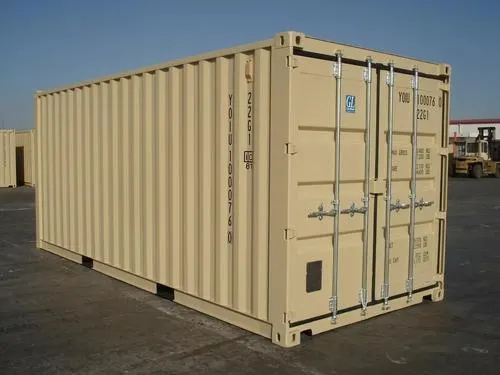
This type is primarily used for storing dry goods such as grains or sugar. They have no doors or windows and come in different sizes according to their capacity.
2. Flat Rack Container
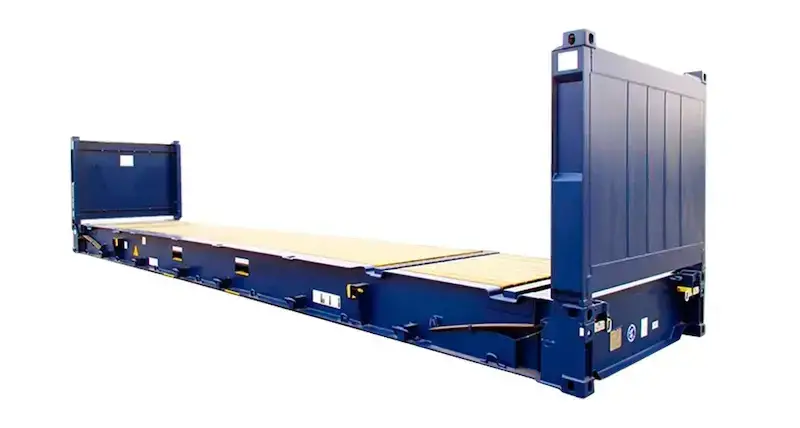
These containers are designed for transporting heavy equipment, such as machinery or vehicles, over long distances. They are made from high-strength steel with a flat top and open sides, making them easier to load than other containers.
3. Tunnel Shipping Container/ Double Door Shipping Containers
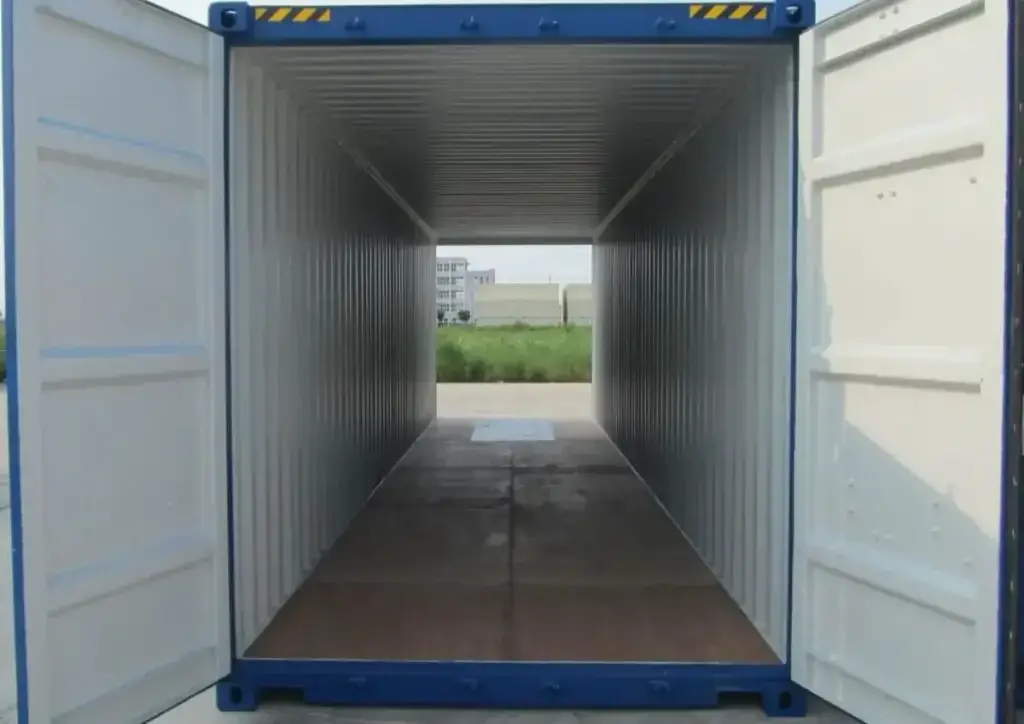
The tunnel container is essentially an elongated version of the standard shipping container. This type of metal box has a curved roof that makes it possible to stack them onto one another.
Malcolm McLean built the first tunnel container in 1956 and owned Pan-Atlantic Steamship Corporation. The design was inspired by the whalebacks during WWII when the US Navy employed it.
4. Open-side Storage Shipping Container

This metal box is typically used for transporting goods on trucks or trains. These containers have no doors or windows but ramps or hydraulic lifts for loading and unloading vehicles.
They are usually cheaper than closed versions because there are fewer features included with this type of cargo carrier.
However, they also offer less protection against weather and theft because they do not have doors or walls like other types of metal boxes.
Read More on How To Join Two Shipping Containers Together
5. Refrigerated ISO Containers
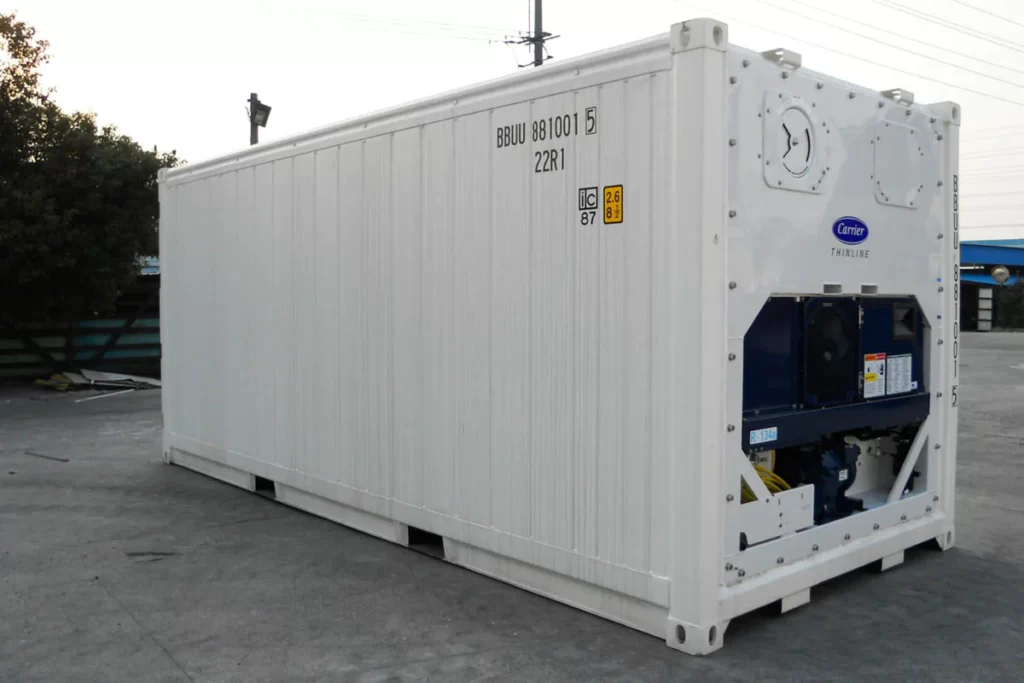
This shipping container has insulated walls and double doors. They are ideal for shipping frozen or temperature-sensitive products.
The double doors allow you to load and unload products faster than regular containers, which only have one entry on one side of the container.
6. Open-top Shipping Containers
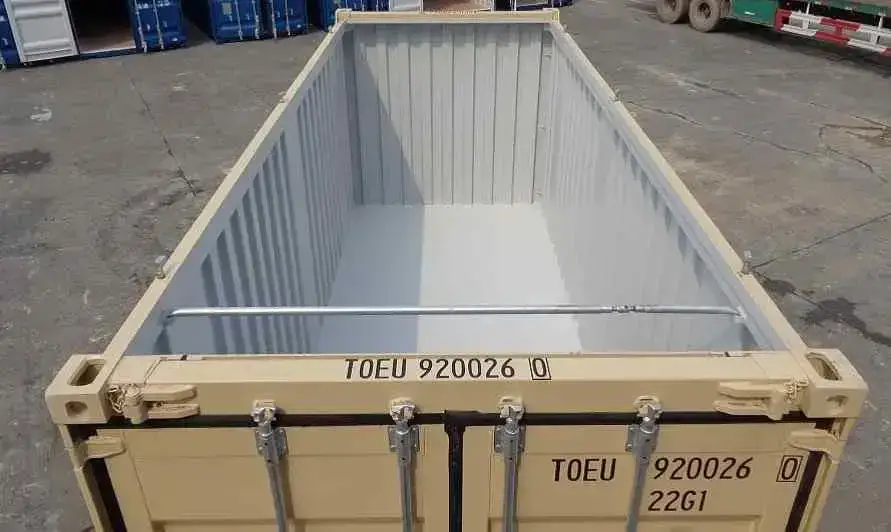
As can be seen, this type of shipping container has an open-top design. These units are used for transporting items that cannot be damaged by exposure to weather conditions such as rain or snowfall, such as sand or gravel for construction projects or wood chips for landscaping projects.
Open-top containers are often used for shipping product samples or samples that need to be inspected before being sold at retail outlets worldwide.
Depending on their capacity, they come in varying sizes, but most have no doors or windows, so they must be loaded from above-using forklifts, trucks, or helicopters.
Read More on 10 Unknown Facts About Shipping Containers – Expert Review
7. Insulated or Thermal Shipping Container
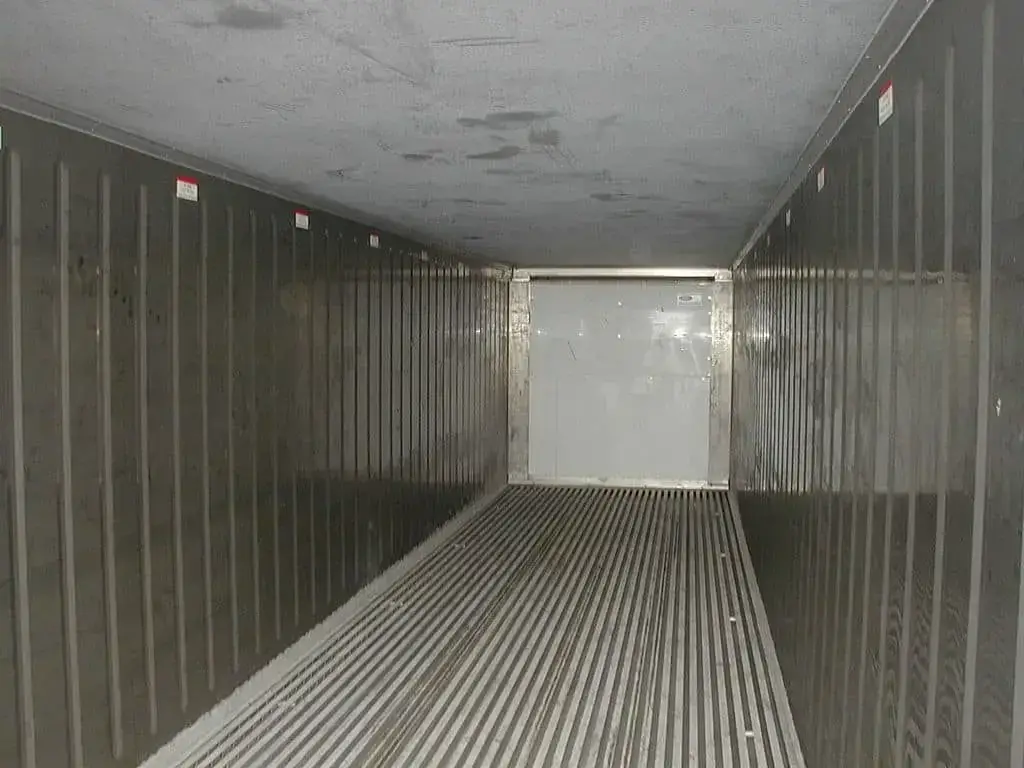
These are usually used for food products like ice cream and dairy. They are insulated to maintain the temperature inside. They come in different sizes and can be customized according to the size and number of pallets required.
8. Tanks
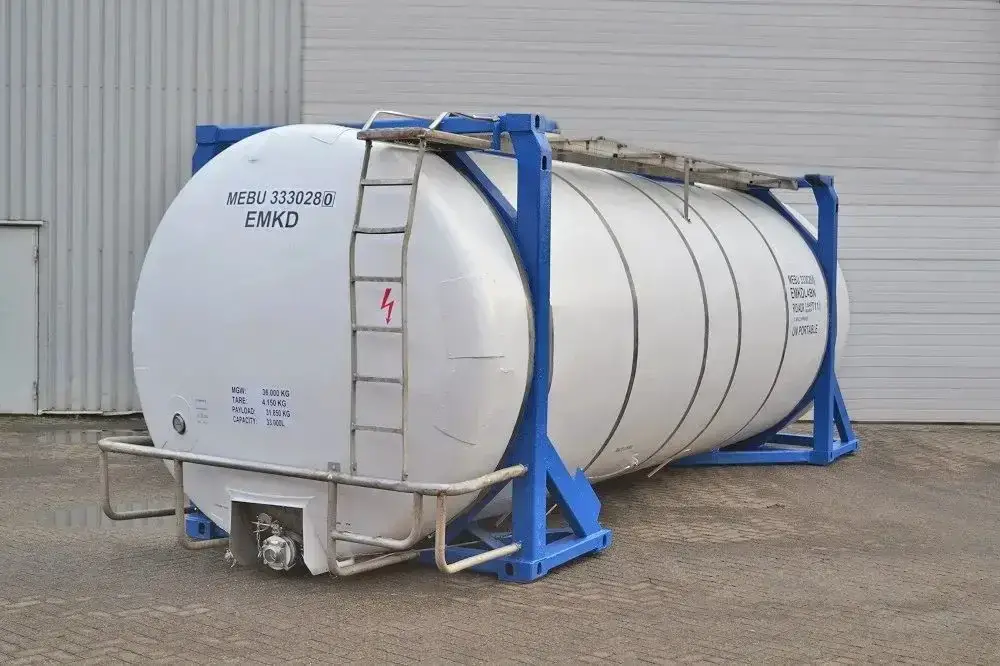
Tanks store liquids, including hazardous materials such as chemicals, oil, and fuels.
The tanks come with different capacities depending on how much liquid you want to store in them and how long you need to store it.
9. Cargo Storage Roll Containers

These are typically used by businesses that need to store large amounts of inventory but don’t have enough space at their location or don’t want to invest in building a warehouse yet.
A cargo storage roll container can be placed outside your business premises or inside, depending on its size and what you need it for.
10. Standard Shipping Container
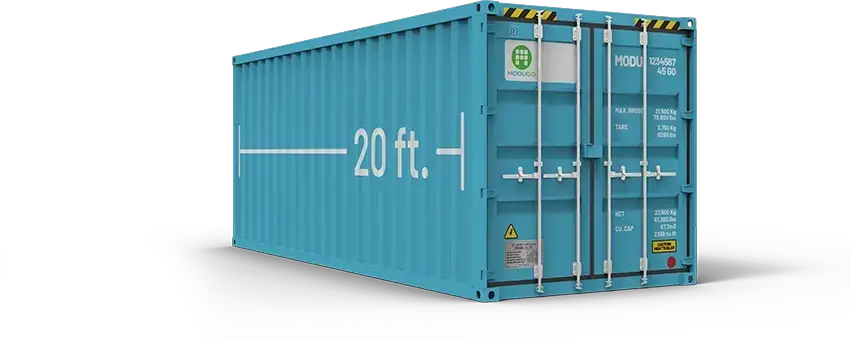
The standard size is 8 x 20 feet (approximately 2.4m x 6m), but other sizes are also available. This type is often used for international shipping or storing goods on ships and trains, though it can be used for other purposes.
11. Half-height Containers
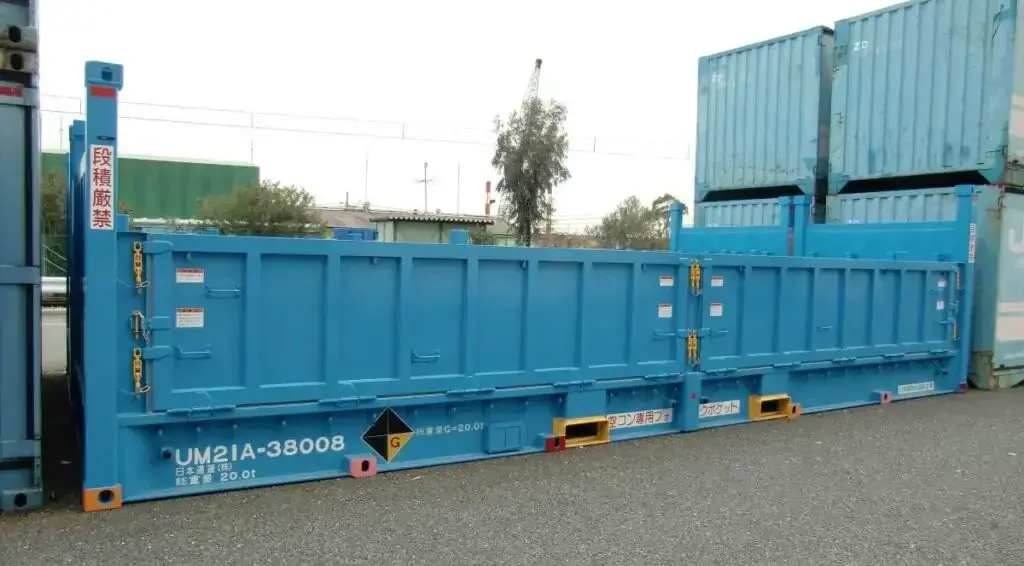
From a quick look of the history of shipping containers, we have seen a rise of half height containers out of necessity. These are smaller versions of standard containers and are generally used to transport goods between warehouses or short distances. They can also be kept on top of one another to create storage space at large events like concerts or festivals.
12. Car Carriers

These containers serve as mobile garages for vehicles during transport by sea or air, allowing them to remain safe while transported worldwide.
They generally come with a door on each side so that cars can be driven into them without having to uncouple them from their trailers and then reattach them once they reach their destination.
13. Intermediate Bulk Shift Containers
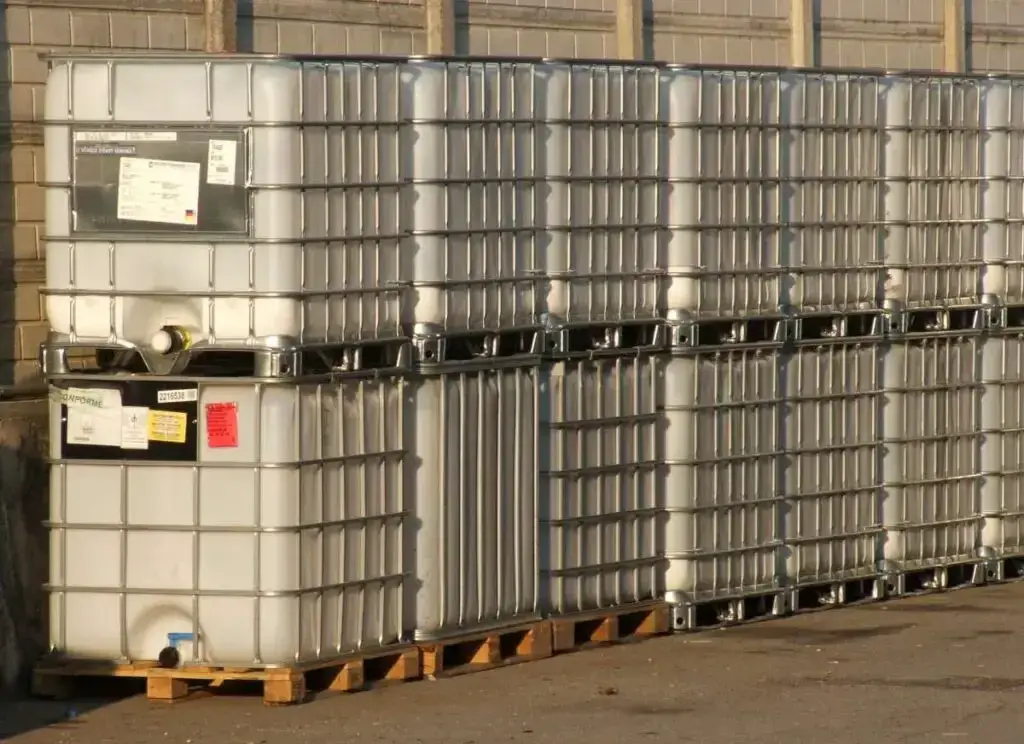
These are the most common type of shipping containers. They measure roughly 45 inches wide by 45 inches long, by 45 inches high.. They are normally used for hauling various chemicals and liquids. But they make an excellent water storage container given that they have an in-built pallet.
14. Drums
These are also known as steel drums, chemical drums, or food-grade drums. They’re usually made from recycled steel and are used primarily for liquids and solids that can’t be stored in other containers.
Depending on what you’re shipping, drums come in various sizes from 5 gallons to 55 gallons. You can even find them in larger sizes if needed.
15. Special-purpose Containers
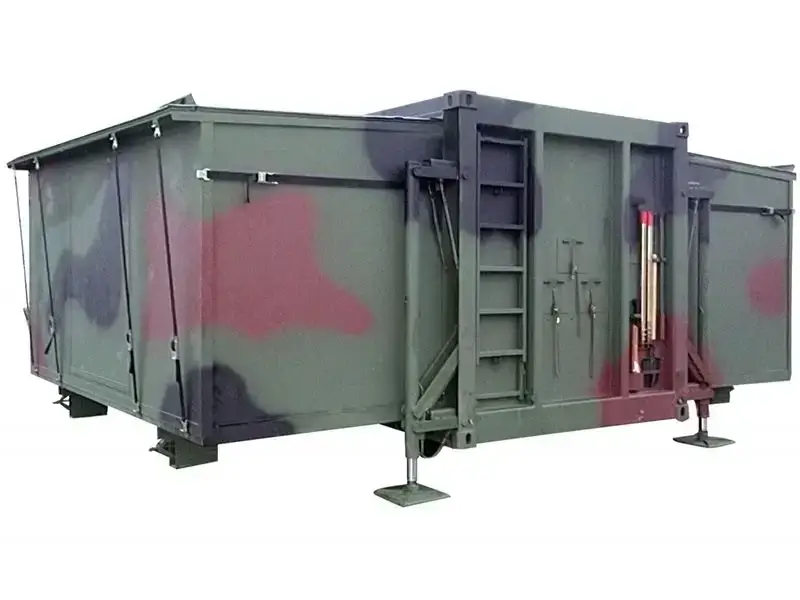
There are many other shipping containers with specialized purposes. For example, swap bodies (also called swap bodies) have a single door on one end and two doors on the other, with ramps connecting them.
These boxes can be moved by forklifts or cranes, allowing them to move around easily while still allowing access through all four sides of the box. Swap bodies can be used for various applications, including warehousing, storage, and distribution centers.
Innovative Ways to Use A Shipping Container
There are many ways to use a shipping container. Here are 10 of the most interesting and innovative uses for shipping containers:
1. Portable Office Shipping Container

A portable office is an idea that has been around for a long time, but it is still a great way to get a small office space without renting or buying one.
It can be put up quickly and taken down just as easily. It’s also a good way to get extra space if you have an unexpected guest coming over or need more room for your growing business.
2. Greenhouse Shipping Container
Greenhouses can be expensive to buy and install, but they don’t have to be! You can make your greenhouse using an old shipping container, which can help you save money while also helping you grow your fruits and vegetables year-round in any climate.
3. Outdoor Kitchen
In the past, if you wanted an outdoor kitchen, you had to have a beautiful patio or deck built to have one.
But now, with shipping containers, you can have your own outdoor kitchen made out of a shipping container. This type of kitchen will last many years and add value to your home.
4. Studio Apartment
You can turn a shipping container into a studio apartment for the elderly or disabled family members who need help with daily activities such as dressing, bathing, and eating.
This setup is perfect for anyone who wants to live independently but cannot take care of themselves due to health problems like Alzheimer’s or dementia.
It also allows them to feel independent while still having someone around when they need assistance with daily activities.
5. Air Conditioning Unit
An air conditioner unit built out of a shipping container is perfect for those who want to keep their homes cool during the hot summer months without having to pay high utility bills every month during those months when it gets extremely hot outside! This is also great if you rent your property because it won’t cost much each month.
6. Garage or Workshop
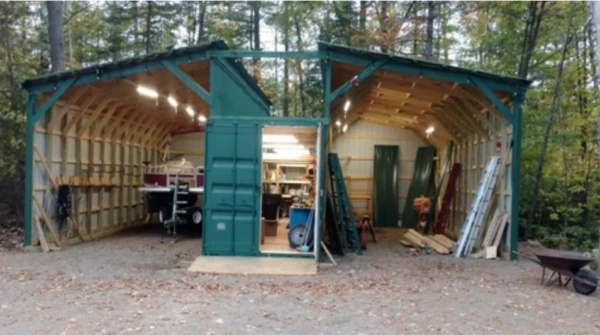
In our study of the history of shipping containers, we have seen that a shipping container can be turned into your garage or workshop. Suppose you don’t have room for one in your backyard.
This is an excellent way to create your own space without having to invest in expensive construction materials. You’ll need some tools if you want to build one yourself, but it’s not too hard if you follow instructions carefully.
7. Playhouse or Treehouse
If you have kids who love to play outside, this idea will make them very happy! A shipping container can be turned into a playhouse or treehouse that they’ll love spending time in during the summer months (or whenever they want).
This is also an excellent way to get them involved in building projects with you, they’ll enjoy watching their new clubhouse come together piece by piece as much as playing inside once it’s finished!
8. Garden Shed or Tool Shed
Homeowners can now create a garden shed from shipping containers at a fraction of the cost of conventional options.
The benefits include being able to customize the size and shape of your storage space, as well as choosing an exterior finish that suits your style.
9. Swimming Pool Or Hot Tub Enclosure

If you are looking for an affordable alternative to building a pool house, consider using a shipping container as your swimming pool enclosure.
Container pools help save construction costs while creating a fun and unique design element for your backyard.
10. Shipping Container Home

If you’re thinking about building a house with all the bells and whistles, then shipping containers might be a good choice.
They’re cheap and easy to work with, which means that they help keep construction costs down significantly compared to conventional home construction methods.
Read More on Experience Luxury Living In Tasmania With Stunning Container Homes
How The History of Shipping Containers Changed The World
The globe has evolved drastically in the previous century, and shipping containers are one of the biggest reasons. The container was invented in 1956 by Malcolm McLean, who founded Sea-Land Service Inc.
He used empty steel tanks lying around to build a prototype that could carry 17 tons of cargo and be stacked on top of one another on ships.
In the years since, this invention has drastically transformed the shipping industry. It’s estimated that more than 90 percent of goods in Europe are shipped using containers, which helps explain why they’re so popular with businesses worldwide.
Here are ways that shipping containers have changed our lives:
1. Housing
Shipping containers have become a popular way to build homes in urban areas. The design of these homes is very different from traditional houses and apartments, but they can be just as comfortable. Some people even say they prefer them to traditional housing.
2. Transportation
Shipping containers have also revolutionized transportation. They’re used on ships, trains, and trucks worldwide.
They’re also used in construction projects to build temporary structures such as offices or stores while permanent ones are built.
3. They Make International Trade Easier
Containers can be carried by any size of ship or plane, from supertankers to jetliners, so you don’t need to worry about how much space your shipment takes up on board.
This makes it easier for companies to import goods from other countries and export them from their own country, leading to increased trade between nations.
4. They Help Protect Against Theft and Damage During Transit
When goods are packed into boxes before being shipped abroad, they’re less vulnerable to theft or damage during transit because they’re easy for customs officers to inspect at every stage of their transportation.
Importance of Shipping Containers
There are many reasons why shipping containers are important in today’s world:
1. Shipping Container is Environmentally Friendly
Shipping containers are built to withstand weather conditions worldwide, so they will last for decades without rusting or rotting away like other types of building materials would do.
They also don’t require much maintenance once you install them in your yard or business location because they don’t require any special care aside from cleaning them up occasionally.
2. They are Affordable
Shipping containers are very reasonable, especially compared to other storage units.
This means that they will not cost you much, which means you can save money on other things like transportation.
Read More on Luxury Container Hotels – Offering Unique Experiences
3. Shipping Container is Portable
Shipping containers can be moved easily from one place to another because they have wheels and axles attached. This makes transporting them easy from one location to another without hassle.
4. They are Versatile
Shipping containers come in different sizes, so you can select the one that suits your needs perfectly. You can modify them any way you want by adding windows or doors or installing plumbing systems.
This makes them highly versatile, flexible, and durable enough for long-term use.
5. Shipping Containers are Durable
From the history of shipping containers, we have seen that one of the main reasons shipping containers are so popular is their durability. They’re made from strong steel and can withstand much abuse during transport.
Some reports claim that these metal boxes can withstand up to 500,000 drops onto concrete without damage!
Read More on Container Pools in NZ – Unparalleled Backyard Beauty
Conclusion: The Enduring Influence of Shipping Containers
Shipping containers have played a monumental role in shaping globalization and revolutionizing the shipping industry. Throughout history, these steel boxes have provided a standardized and efficient method for transporting goods across the globe.
From the early shipping methods that faced numerous challenges to the birth of containerization by Malcolm McLean, the evolution of shipping containers has been astounding. Intermodal transportation and multimodal systems further enhanced the efficiency and accessibility of containerization.
The economic impact of containerization cannot be understated. By streamlining the shipping process and reducing costs, businesses were able to broaden their markets and increase profitability. The technological advancements in shipping methods have only further improved the efficiency and safety of container shipping.
Port infrastructure and operations have also evolved to accommodate the growth in container traffic. The rise of large vessels and the need for efficient terminal operations have led to the development of state-of-the-art ports and logistics hubs.
While the environmental impact of shipping containers has raised concerns, efforts are being made to promote sustainability and reduce carbon emissions. Innovations in green shipping technologies and eco-friendly practices aim to minimize the ecological footprint of the shipping industry.
Influence of Shipping Containers
In conclusion, while looking at the history of shipping containers, we have seen that shipping containers have had a profound and lasting influence on globalization and trade.
The standardized system introduced by containerization has revolutionized the shipping industry, making it faster, safer, and more cost-effective. Despite challenges and environmental concerns, containerization continues to be a vital component of global trade.
Looking to the future, shipping containers will continue to play a crucial role in the shipping industry. As e-commerce and international trade continue to grow, the demand for efficient and reliable shipping methods will only increase.
Therefore, it can be expected that shipping containers will remain relevant and integral to global commerce for years to come.
Read More on Best Poolside Container Plants – Stunning Pool Area Choices

